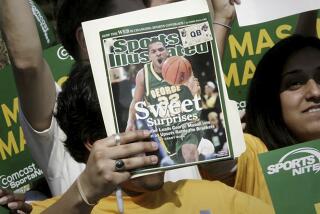A Consumer Guide to the Information Age
- Share via
Steven Brill has been looking for a few good men and women--fellow journalists--to follow him on a crusade to “help redeem the values we care about.”
In a resume-seeking ad that he placed in American Journalism Review, he explained that Content, his new media-watching monthly, will be “based on a simple premise: that it’s time for a broad-based consumer magazine that separates true journalists from the charlatans in a way that redeems the values of our profession.”
Brill, 47, is a player, founding editor of the American Lawyer magazine and the founding force behind Court TV.
Lately he’s been loading his guns for what will be one of the more closely watched launches of 1998 since freeing his hands last February. That’s when a disagreement involving Ted Turner, vice chairman of majority owner Time Warner, ended with the media conglomerate buying out Brill’s interest in the law magazine, the cable channel and his other properties for as much as $40 million.
This time, Brill says, starting up will be easier.
“First of all,” he explained, “I don’t have as much trouble recruiting, or getting advertisers to return phone calls.”
Seated on a cold morning in the Time Warner building--temporary office space, he made clear--he was wearing striped suspenders, pinstriped pants and a pink shirt. He was fingering a big unlit cigar.
“I think everybody has a sense of being bombarded from all different sides and from all different kinds of media--print, magazines, Web sites, docudramas, infotainment, ‘push’ news on a computer screen, pagers and God knows what,” he said. “And there’s no sense of what you can rely on anymore . . . .”
“Who’s doing stuff that is credible and up to professional standards and who’s not? And mixed in with that is my sense that the way to elevate the standards of journalism is to have someone, or some publication out there, that’s looking at who’s doing what, holding journalists as accountable as they like to hold everybody else.”
Who will join his crusade? Brill, the editor in chief, would not say--yet.
Meanwhile, a dummy copy of Content contains headlines suggesting the kinds of stories the magazine will go after: “We’re Never Sorry (Just Try Getting the Networks to Make a Correction)” . . . “Ad-Corrupted Web Sites” . . . “Best Regional Newspapers” . . . “Five Financial Pundits Who Are Never Right” . . . “How Fortune Got So Good” . . . “Diane Sawyer’s Three Sappiest Interviews.”
Brill says he wants to assess the qualifications of reporters assigned to major beats and perhaps figure out which of the all-news cable channels is the most reliable.
Brill insists that Content, unlike the American Journalism Review and the Columbia Journalism Review, is not aimed at other journalists, but at a broad consumer audience.
Content will launch in June.
Tom Goldstein, the new dean of Columbia University’s Graduate School of Journalism and overseer of the Columbia Journalism Review, said Content “is a very ambitious project. Many people have tried similar ventures and not succeeded--but they were not Steve Brill . . . .”
“Everybody keeps saying that we’re now living in an Information Age . . . ,”Brill said. “This is going to be the magazine of that age. It will attempt to be a consumer guide to the Information Age.”
* Paul D. Colford is a columnist for Newsday. His e-mail address is [email protected]. His column is published Thursdays.
More to Read
Inside the business of entertainment
The Wide Shot brings you news, analysis and insights on everything from streaming wars to production — and what it all means for the future.
You may occasionally receive promotional content from the Los Angeles Times.









